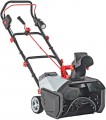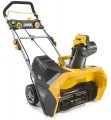Working width
The width of the strip of snow that the snow blower can clear in one pass. The larger the capture width, the fewer passes will be required to process the site, which is especially important on large areas. On the other hand, for processing small spaces, clearing individual paths, etc. significant width is not required (moreover, a “narrow” snow blower will pass more easily in a hard-to-reach place). The larger the capture width, the more powerful the engine, usually, ceteris paribus.
The most compact modern snow blowers have a working width of
less than 50 cm, these are mainly electric models of low power, although gasoline units are also found. A width of
50 – 60 cm can be called relatively small,
60 – 70 cm — medium, and in the largest models this figure
exceeds 70 cm.
Working mechanism
The type and material of the working mechanism, which is standardly installed in the snow blower.
—
Steel auger. An auger is a structure of several spirally curved plates that, due to rotation, ensure the movement of snow from the surface being cleared and throw it in the desired direction. Metal augers have high hardness and strength, due to which they are well suited for working with hard crust, dense compacted snow and high snowdrifts. On the other hand, such a tool can damage the coating under the snow, so such devices are poorly suited for work on paths with decorative coating. Also, a metal auger can break from a collision, say, with a stone, and therefore requires the use of safety systems (shear pins). Such augers are usually equipped with powerful self-propelled models, in which the working tool does not fit tightly to the ground.
—
Rubber auger. A type of auger (see above) made of rubberized material. Such augers are softer than steel ones, which means they can be used to clear paths with decorative coverings without fear of damaging the surface. At the same time, they are suitable for working only with loose, freshly fallen snow — such augers cope much worse with dense snowdrifts or crust than metal ones, and in this mode they quickly wear out and become unusable. Rubberized (or even solid rubber) augers are usually installed on non-self-propelled models, in which the tool can
...fit closely to the ground.
— Plastic auger. The advantages of plastic as a material for augers are low cost and good hardness, due to which such augers cope much better with frozen crust and compacted snow than rubberized ones. At the same time, they are much more careful with the road surface than metal ones, due to which they can be used almost close to the ground. At the same time, plastic is characterized by fragility and a tendency to crack when colliding with hard obstacles, and therefore this material is used relatively rarely and mainly in inexpensive snow blowers.
— Sweeper brush. A rotating cylindrical brush with long, rigid "bristles" fixed on a horizontal axis. This mechanism is designed to work with soft, loose snow of shallow depth. Its main advantage is the combination of cleanliness of processing and a good width of capture: the brush can provide a capture strip of 60-80 cm, leaving behind almost completely cleared soil. At the same time, it can be used on relatively "delicate" surfaces. But for high snowdrifts or densely packed snow, it is better to use augers.
— Steel auger/sweeper brush. In this case, the snow blower is equipped with both types of working mechanisms (see above for more details), and the operator can install the most suitable for the given conditions. This provides the greatest versatility: for example, you can remove the crust with a metal auger, and then install the brush and sweep the area clean.
— Blade. A device made of curved metal sheet for clearing snowdrifts. Allows for large volumes of work, used for clearing freshly fallen snow from access roads, parking lots, areas near garages or entrance gates to a private plot. To prevent damage to delicate road surfaces, a rubber coating is often “put on” the lower part of the blade. Based on the working situation, three fixed positions of the blade are usually assumed: vertically, with an inclination to the right or left.Auger / brush diameter
The diameter of the working tool of the snow blower. Other things being equal (primarily engine power), a smaller diameter auger gives more force during rotation, and a larger diameter auger allows you to process more snow in the same time. Therefore, units with large augers can be recommended primarily for working with large volumes of relatively soft snow, and with small ones — for dense packed cover and crust.
Battery voltage
Nominal voltage of the battery used in the unit with the corresponding engine type (see above). Theoretically, a higher voltage allows you to achieve more power, but in fact there is no direct relationship between these points. In addition, manufacturers choose batteries to deliver the intended power, rotational speed, and other performance. Therefore, in the selection and normal use of the unit, this parameter has a secondary, reference value; it may be needed mainly for some specific tasks, for example, searching for a spare battery or a “non-native” charger, or comparing different batteries by capacity (see below).
Compatible batteries
The name of the battery that is compatible with the device. It helps to buy a spare or find a suitable one in case of a breakdown of the main one.
Battery
Features of the battery that the snow blower of the corresponding design is equipped with (see “Engine type”). This item is relevant only for those models, the equipment of which differs from the classic version of the “unit + battery”, namely:
— Not included.
No battery included. This option is not very convenient at first glance — the snow blower cannot be used out of the box, you need to purchase a battery. On the other hand, this battery can be chosen at your own discretion, without relying on the decision of the manufacturer. Also, this configuration option is useful for those who already have a suitable battery “in the household”.
— 2 batteries. The presence of two batteries at once in the scope of delivery of the snow blower. This configuration affects the price, but it also has its advantages. The most obvious of them is the doubled battery life: when the charge is exhausted, you can replace the dead battery with a fresh one and continue driving. Moreover, in this way, you can also reduce the breaks for charging: while one battery is in use, the second can be charged. At the same time, such capabilities are rarely required, and most battery-powered snow blowers allow you to purchase a second battery separately if you wish. Therefore, this configuration option has not received much distribution.
Wheels diameter
Snow blower wheel diameter. Permeability primarily depends on this parameter: the larger the diameter of the wheels, the easier they will overcome obstacles in the form of curbs, stones, bumps, etc. This is especially important for self-propelled models (see "Design"); on the other hand, larger wheels require a more powerful engine. Therefore, if the unit is to be used on more or less flat terrain, it makes sense to choose a model with smaller wheels.
The smallest diameter found in modern snow blowers is about 12 – 13 cm; in the largest and heaviest models, it can reach 50 cm.
Noise level
The average noise level produced by the snow blower during operation; the actual volume may differ slightly from this figure, but these deviations are usually negligible.
Note that snow blowers are quite loud equipment, plus the higher the power, the generally higher the noise level. This parameter is measured in decibels, this is a non-linear value, so the actual loudness is easiest to evaluate using comparative tables. So, the most "quiet" modern models give out about 55 – 60 dB — this can be compared with a conversation in slightly raised tones. 70 dB corresponds to a loud conversation, 80 dB to noise on a busy city street, 90 dB to a freight car at a distance of about 7 m, 100 dB to an industrial workshop, 110 dB to a tractor motor at a distance of 1 m.
The lower the noise level, the more comfortable this model will be to use. And according to sanitary standards, the maximum noise level considered safe for prolonged exposure (up to 8 hours) is 80 dB. So if the selected unit is noisier, and you plan to work often and for a long time, you should take care of protective headphones or earplugs.

